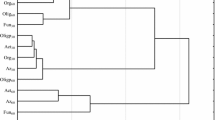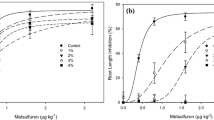Abstract
Microorganisms play a major role in the degradation and detoxification of most soilapplied pesticides. Any interference with soil microbial activity may affect the persistence as well as the effectiveness of the pesticide. The objective of this study was to investigate the effect of granulated superphosphate fertilizers on terbutryn (2-(tert-butylamino)-4-(ethylamino)-6-(methylthio)-l,3,5-triazine) degradation and on its herbicidal activity. Concentrations exceeding 1% of superphosphate in the soil slowed down terbutryn degradation; a concentration of 3% completely inhibited terbutryn degradation for nearly 60 days. When terbutryn was impregnated on the surface of superphosphate granules, the concentration of the fertilizer that inhibited terbutryn degradation was reduced from 3% to 0.1%. Bioassays with mustard seedlings confirmed the results obtained by chemical analysis of terbutryn. The decrease in the rate of terbutryn degradation was not specific to superphosphate. The inhibition of degradation could be attributed mainly to the concentration of the salt in the soil solution, expressed as electrical conductivity values, and not to the pH of the soil or to the type of the salt. Terbutryn was found to be quite stable on the surface of the superphosphate granule. At the concentrations tested, superphosphate did not affect root growth. The optimal weight of the impregnated granule for extending terbutryn activity was 125 mg, containing 0.2% terbutryn. A greenhouse experiment confirmed the findings that fertilizers could serve as potential inhibitors of terbutryn degradation.
Similar content being viewed by others
References
Aharonson, N., Rubin, B., Katan, J. and Benjamin, A. (1983) Effect of methyl bromide or solar heating treatment on the persistence of pesticides in soil.Proc. 5th Int. Congr. of Pesticide Chemistry (Kyoto, Japan), pp. 189–194.
Avidov, E., Aharonson, N., Katan, J., Rubin, B. and Yarden, O. (1985) Persistence of terbutryn and atrazine in soil as affected by soil disinfestation and fungicides.Weed Sci. 33: 457–461.
Doyle, R.C., Kaufman, D.D. and Burt, G.W. (1978) Effect of dairy manure and sewage sludge on14C-pesticide degradation in soil.J. Agric. Food Chem. 26:987–989.
Ferris, I.G. and Lichtenstein, E.P. (1980) Interaction between agricultural chemicals and soil microflora and their effects on the degradation of14C parathion in cranberry soil.J. Agric. FoodChem. 28:1011–1019.
Katan, J. and Aharonson, N. (1989) Accelerated degradation of pesticides,in: Gerstl, Z., Chen, Y., Mingelgrin, U. and Yaron, B. [Eds.] Toxic Organic Chemicals in Porous Media. Ecological Studies 73, pp. 193–207. Springer-Verlag, Berlin.
Kaufman, D.D., Katan, J., Edwards, D.F. and Jordan, E.J. (1985) Microbial adaptation and metabolism of pesticides,in: Hilton, J.L. [Ed.] Agricultural Chemicals of the Future. Rowman and Allanheld, Totowa, NJ. pp. 437–451.
Laura, R.D. (1977) Salinity and nitrogen mineralization in soil.Soil. Biol. Biochem. 9: 333–336.
Lichtenstein, E.P., Liang, T.T. and Koeppe, M.K. (1982) Effects of fertilizers, captafol, and atrazine on the fate and translocation of C-fonofos and C-parathion in a soil-plant microcosm.J. Agric. Food Chem. 30:871–878.
McCormick, R.W. and Duane, W.C. (1980) Effect of sodium chloride on CO2 evolution, ammonification and nitrification in a sassafras sandy loam.Soil Biol. Biochem. 12:153–157.
Petty, H.B., Burnside, O.C. and Bryant, J.P. (1971) Fertilizer combinations with herbicides or insecticides,in: Olson, R.A. [Ed.] Fertilizer Technology and Use. Soil Sci. Soc. Am. Inc., Madison, WI. 2nd ed., pp. 495–515.
Rajagopal, R.S. and Sethunathan, N. (1984) Influence of nitrogen fertilizers on the persistence of carbaryl and carbofuran in flooded soils.Pestic. Sci. 15:591–599.
Roeth, F.W. (1986) Enhanced herbicide degradation in soil with repeated application.Rev. Weed Sci. 2:45–65.
Roslycky, E.B. (1980) Fungicidal activity of vorlex and accumulation of linuron in vorlexlinuron treated soil.Can. J. Soil Sci. 60:651–656.
Rubin, B. and Benjamin, A. (1983) Solar heating of the soil: Effect on weed control and on soil-incorporated herbicides.WeedSci. 31:819–822.
Ryan, J.A. and Sims, J.L. (1974) Effect of phosphate and chloride salts on microbial activity in flooded soil.Soil Sci. 118:95–101.
Author information
Authors and Affiliations
Rights and permissions
About this article
Cite this article
Sharon, A., Aharonson, N. & Kafkafi, U. Extended terbutryn persistence and herbicidal activity effected by superphosphate fertilizer. Phytoparasitica 21, 111–122 (1993). https://doi.org/10.1007/BF02980882
Received:
Issue Date:
DOI: https://doi.org/10.1007/BF02980882




